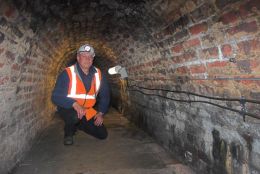Posted 3rd June 2008 | 1 Comment
Fighting 14 million gallons of water a day

Maintenance worker Dave Fuller in one of the tunnels which drains water from the Severn Rail Tunnel
NETWORK Rail is applying a new type of paint to Scotland’s Forth Bridge which will enable painting to stop for around 25 years.
However, there are no such new-tech fixes inside the 4.5-mile Severn Tunnel, the longest main line tunnel in Britain, where diesel fumes combine with moisture to corrode steel rails so rapidly that they need replacing every six years.
Behind the scenes, there’s also a continuous effort to prevent the tunnel flooding.
Little do passengers realise that the Severn Tunnel, opened in 1886, is actually several interconnected tunnels, only one of which is used by trains. Beneath the 4.5-mile main tunnel are drainage tunnels that take water to the powerful pumps at Sudbrook on the eastern side.
Dave Fuller, part of the tunnel’s maintenance team for the last 24 years, says very little seawater enters the tunnel. Most comes from an underground spring, which flooded the tunnel workings during the original construction.
In 2007, 13.86 million gallons of spring water were pumped out every day on average. A pipeline then takes two million gallons a day to a brewery that opened a few miles away in 1979 to take advantage of the tunnel’s water supply. A nearby paper mill, which also used the spring water, closed two years ago.
A further 6.6 million gallons per day on average enters the Severn Tunnel from the farmland above it. About half of the tunnel is situated underneath Monmouthshire, and some rain- water also drains into it from the land on the English side.
In one part of the Severn Tunnel running about 200ft beneath Sudbrook, Dave leads the way into a low brick-lined tunnel and lifts a wooden floorboard to reveal a stream. He plunges in a forearm and the water dams up vigorously – and this is a weaker flow than usual, Dave says.
“When the crops are growing, they take up quite a bit of the water,” he explains.
There’s also a 30-yard tunnel beneath the main one, built as an escape route for the rush of air created when two trains pass near the centre.
Standing in one of the Sudbrook headers (passageways connecting the main tunnel to the shafts), there is a noticeable change in air pressure when a train enters at the English portal, more than two miles away. The sensation acts as a vital warning, as anyone inside the tunnel would be unable to see an approaching train because of a bend, and noisy ventilation equipment would stop them hearing it until it was very close.
Even with electric lights and lifts, this damp underground world of tunnels, pumps and shafts looks and feels Dickensian. It takes some adjustment to go from there to the control room above, where operator Malcolm Brown sits at a 21st-century computer monitor. With just a click of his mouse he can stop or start any of the 14 massive pumps or four electric fans spread throughout the tunnels.
A big panel on the wall above him shows which ones are currently in action – at that moment, seven pumps and three fans are hard at work. There are also a number of additional pumps that can be used to allow maintenance or in case of breakdown, and emergency generators that start automatically 30 seconds after a power cut.
The fans – which can operate at up to 1,000 revolutions per minute if necessary – push fresh air into the central section of the tunnel and help drive train exhaust fumes out of the portals. Occasional steam-hauled excursions further test the ventilation system – not to mention the fire detectors in the shafts, which so far have not been triggered.
But their coal-fuelled journey through the Severn Tunnel isn’t always without incident.
“After a steam train passes, the smoke pours out of the portals,” says Malcolm, who has worked at Sudbrook for 32 years. “One day someone passing saw all this smoke rising and rang the fire service!”
Reader Comments:
Views expressed in submitted comments are that of the author, and not necessarily shared by Railnews.

Howard MARSHALL, Kington
[This comment was deleted because it was out of time. (See Contributor’s Guidelines).]